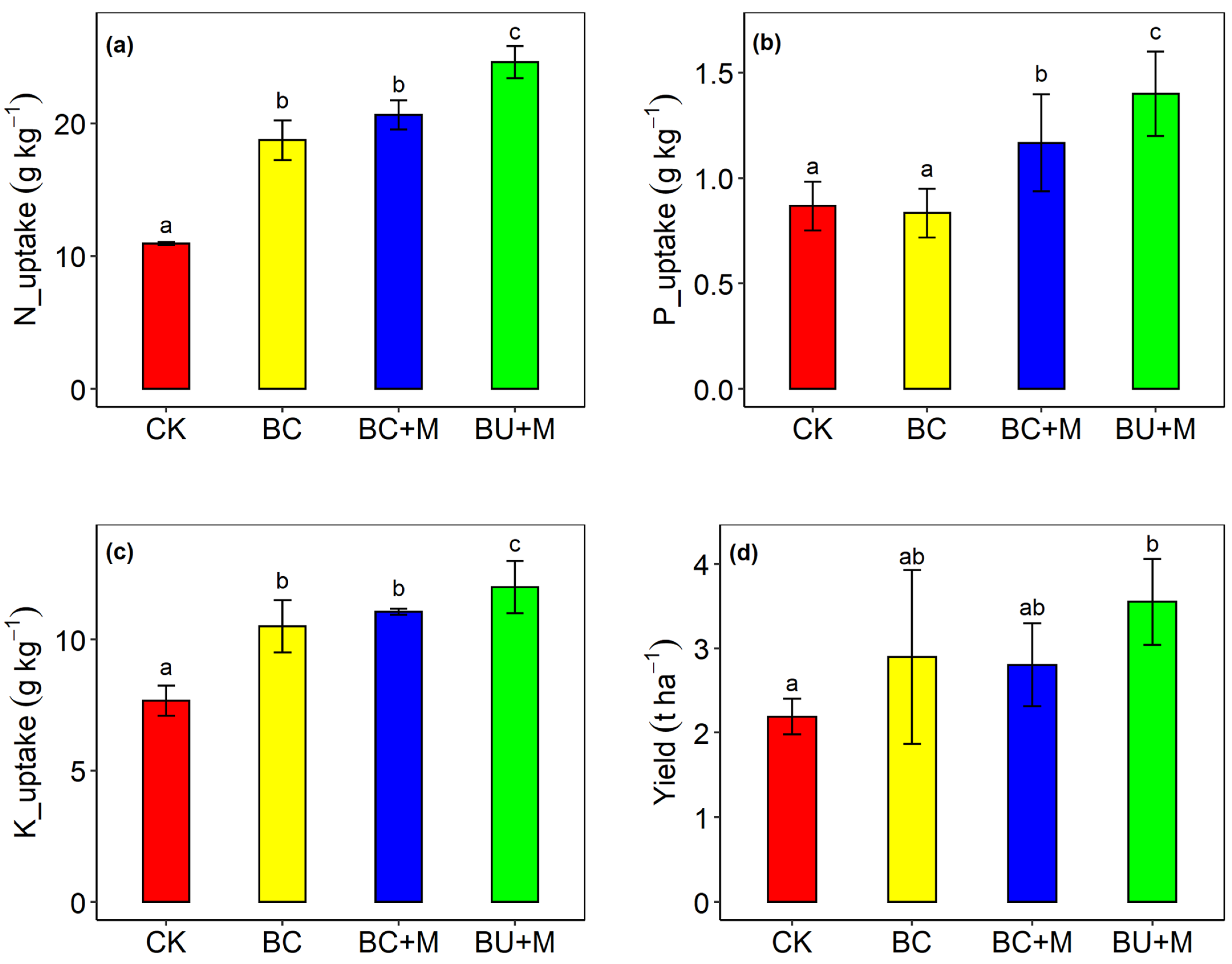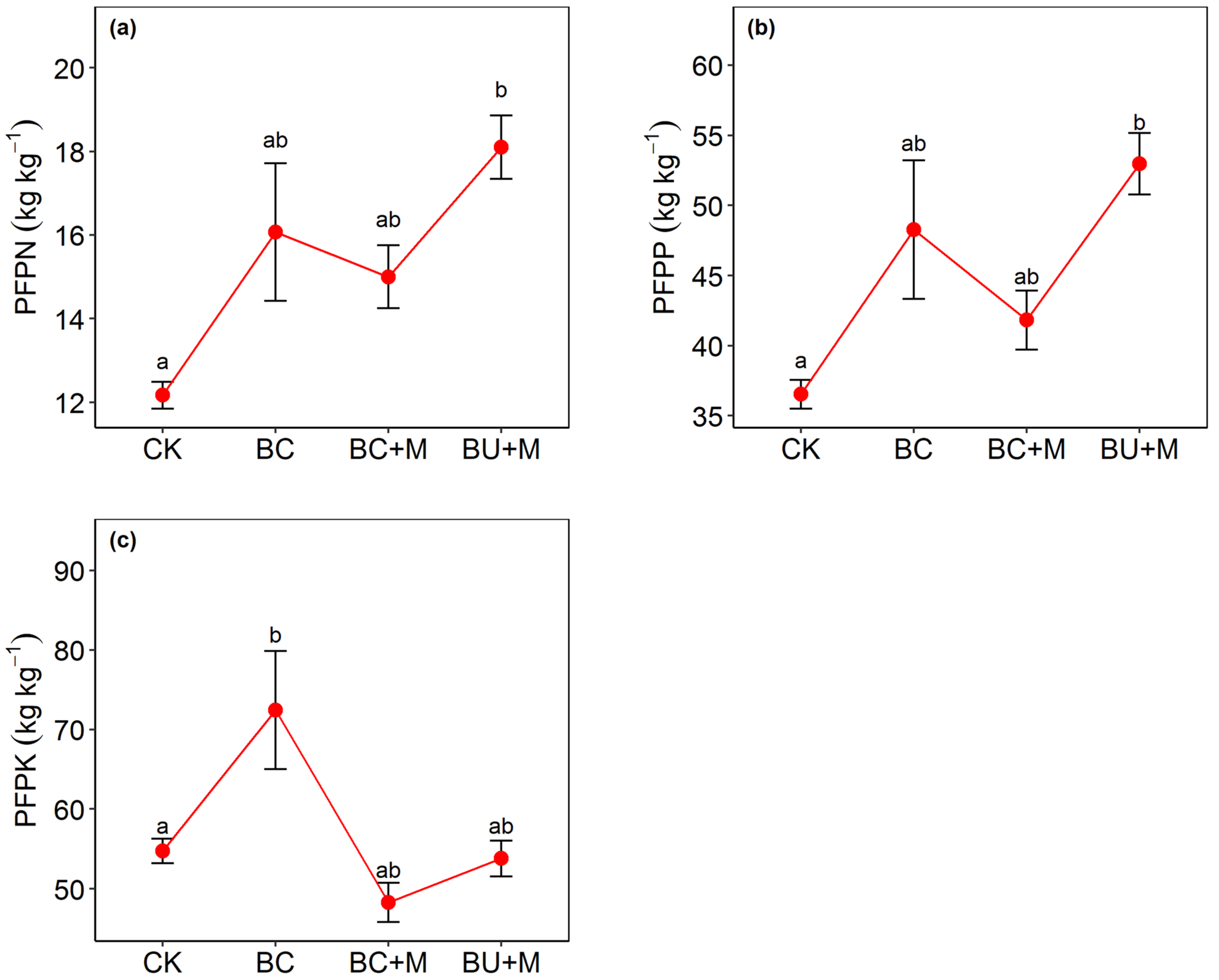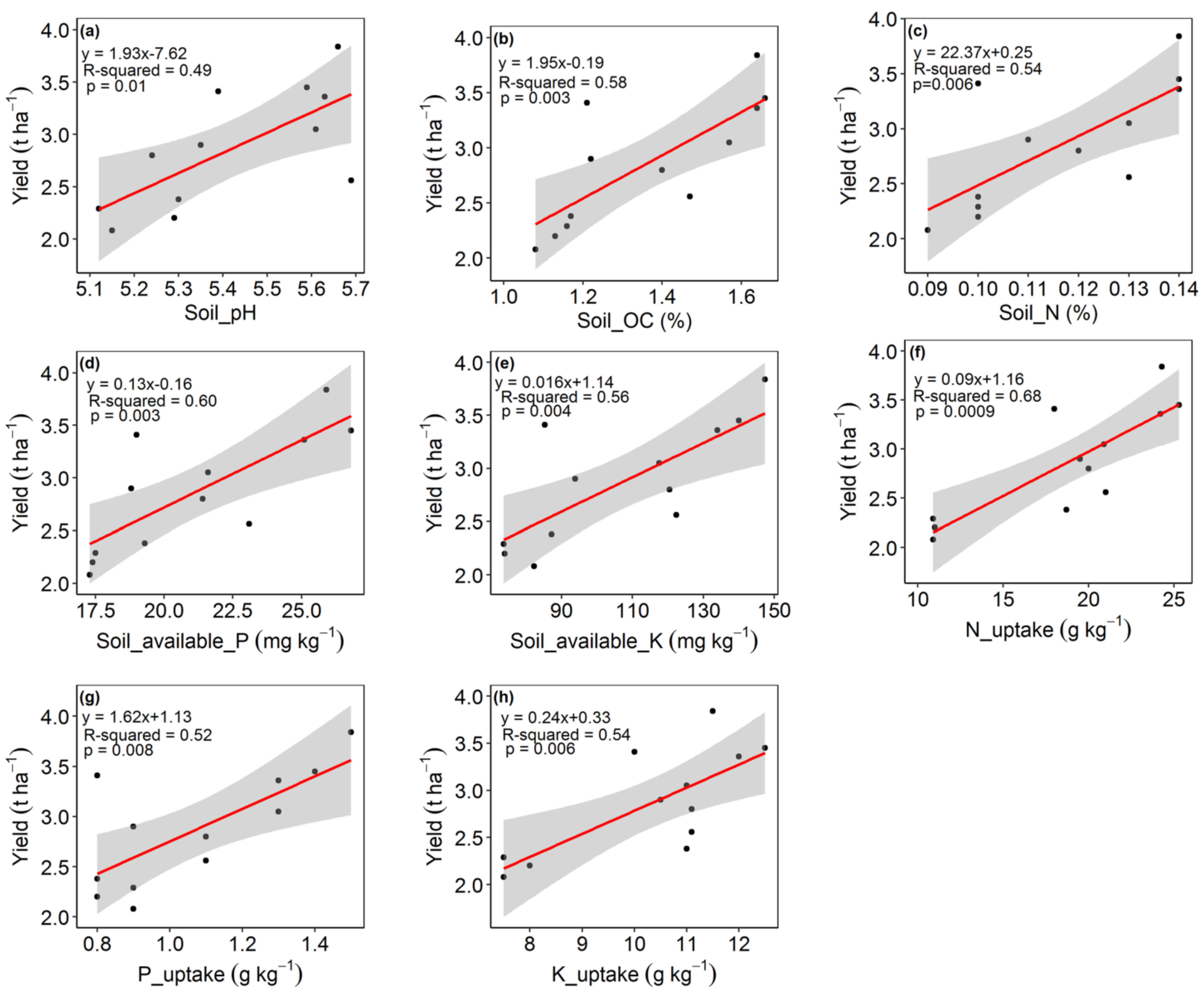Cattle-Urine-Enriched Biochar Enhances Soil Fertility, Nutrient Uptake, and Yield of Maize in a Low-Productive Soil
Abstract
1. Introduction
2. Materials and Methods
2.1. Study Site
2.2. Biochar and Urine-Enriched Biochar
2.3. Experimental Setup and Cultivation Practices
2.4. Soil and Plant Analysis
2.5. Grain Yield and Nitrogen Use Efficiency
2.6. Statistical Analysis
3. Results
3.1. Soil Properties
3.2. Nutrient Uptake by Plants
3.3. Maize Productivity and PFP
3.4. Relationship between Soil Chemical Properties, Plant Nutrient Uptake, and Yields
4. Discussion
5. Conclusions and Future Prospect
Supplementary Materials
Author Contributions
Funding
Data Availability Statement
Acknowledgments
Conflicts of Interest
References
- Paudyal, K.R. Maize in Nepal: Production Systems, Constraints, and Priorities for Research; Cimmyt: El Batan, Mexico, 2001; ISBN 9993320501. [Google Scholar]
- Brown, S.; Schreier, H.; Shah, P.B.; Lavkulich, L.M. Modelling of Soil Nutrient Budgets: An Assessment of Agricultural Sustainability in Nepal. Soil Use Manag. 1999, 15, 101–108. [Google Scholar] [CrossRef]
- Zhang, X.; Davidson, E.A.; Mauzerall, D.L.; Searchinger, T.D.; Dumas, P.; Shen, Y. Managing Nitrogen for Sustainable Development. Nature 2015, 528, 51–59. [Google Scholar] [CrossRef] [PubMed]
- Cornelissen, G.; Martinsen, V.; Shitumbanuma, V.; Alling, V.; Breedveld, G.D.; Rutherford, D.W.; Sparrevik, M.; Hale, S.E.; Obia, A.; Mulder, J. Biochar Effect on Maize Yield and Soil Characteristics in Five Conservation Farming Sites in Zambia. Agronomy 2013, 3, 256–274. [Google Scholar] [CrossRef]
- Pandit, N.R.; Schmidt, H.P.; Mulder, J.; Hale, S.E.; Husson, O.; Cornelissen, G. Nutrient Effect of Various Composting Methods with and without Biochar on Soil Fertility and Maize Growth. Arch. Agron. Soil Sci. 2019, 66, 250–265. [Google Scholar] [CrossRef]
- Acharya, N.; Vista, S.P.; Shrestha, S.; Neupane, N.; Pandit, N.R. Potential of Biochar-Based Organic Fertilizers on Increasing Soil Fertility, Available Nutrients, and Okra Productivity in Slightly Acidic Sandy Loam Soil. Nitrogen 2022, 4, 1–15. [Google Scholar] [CrossRef]
- Vista, S.P.; Pandit, N.R. Biochar for Improving Crop Production in Nepal. SAARC J. Agric. 2023, 21, 227–238. [Google Scholar] [CrossRef]
- Yamato, M.; Okimori, Y.; Wibowo, I.F.; Anshori, S.; Ogawa, M. Effects of the Application of Charred Bark of Acacia Mangium on the Yield of Maize, Cowpea and Peanut, and Soil Chemical Properties in South Sumatra, Indonesia. Soil Sci. Plant Nutr. 2006, 52, 489–495. [Google Scholar] [CrossRef]
- Martinsen, V.; Mulder, J.; Shitumbanuma, V.; Sparrevik, M.; Børresen, T.; Cornelissen, G. Farmer-led Maize Biochar Trials: Effect on Crop Yield and Soil Nutrients under Conservation Farming. J. Plant Nutr. Soil Sci. 2014, 177, 681–695. [Google Scholar] [CrossRef]
- Cornelissen, G.; Nurida, N.L.; Hale, S.E.; Martinsen, V.; Silvani, L.; Mulder, J. Fading Positive Effect of Biochar on Crop Yield and Soil Acidity during Five Growth Seasons in an Indonesian Ultisol. Sci. Total Environ. 2018, 634, 561–568. [Google Scholar] [CrossRef]
- Liang, B.; Lehmann, J.; Solomon, D.; Kinyangi, J.; Grossman, J.; O’Neill, B.; Skjemstad, J.O.; Thies, J.; Luizão, F.J.; Petersen, J.; et al. Black Carbon Increases Cation Exchange Capacity in Soils. Soil Sci. Soc. Am. J. 2006, 70, 1719. [Google Scholar] [CrossRef]
- Kocsis, T.; Kotroczó, Z.; Kardos, L.; Biró, B. Optimization of Increasing Biochar Doses with Soil–Plant–Microbial Functioning and Nutrient Uptake of Maize. Environ. Technol. Innov. 2020, 20, 101191. [Google Scholar] [CrossRef]
- Kizito, S.; Luo, H.; Lu, J.; Bah, H.; Dong, R.; Wu, S. Role of Nutrient-Enriched Biochar as a Soil Amendment during Maize Growth: Exploring Practical Alternatives to Recycle Agricultural Residuals and to Reduce Chemical Fertilizer Demand. Sustainability 2019, 11, 3211. [Google Scholar] [CrossRef]
- dos Santos, S.R.; Lustosa Filho, J.F.; Vergütz, L.; Melo, L.C.A. Biochar Association with Phosphate Fertilizer and Its Influence on Phosphorus Use Efficiency by Maize. Cinch. Agrotecnol. 2019, 43, e025718. [Google Scholar] [CrossRef]
- Puga, A.P.; Grutzmacher, P.; Cerri, C.E.P.; Ribeirinho, V.S.; de Andrade, C.A. Biochar-Based Nitrogen Fertilizers: Greenhouse Gas Emissions, Use Efficiency, and Maize Yield in Tropical Soils. Sci. Total Environ. 2020, 704, 135375. [Google Scholar] [CrossRef] [PubMed]
- Lehmann, J.; Gaunt, J.; Rondon, M. Bio-Char Sequestration in Terrestrial Ecosystems–a Review. Mitig. Adapt. Strateg. Glob. Change 2006, 11, 395–419. [Google Scholar] [CrossRef]
- Jeffery, S.; Abalos, D.; Prodana, M.; Bastos, A.; van Groenigen, J.W.; Hungate, B.; Verheijen, F. Biochar Boosts Tropical but Not Temperate Crop Yields. Environ. Res. Lett. 2017, 12, 053001. [Google Scholar] [CrossRef]
- Jeffery, S.; Verheijen, F.G.A.; Van Der Velde, M.; Bastos, A.C. A Quantitative Review of the Effects of Biochar Application to Soils on Crop Productivity Using Meta-Analysis. Agric. Ecosyst. Environ. 2011, 144, 175–187. [Google Scholar] [CrossRef]
- Liu, X.; Zhang, A.; Ji, C.; Joseph, S.; Bian, R.; Li, L.; Pan, G.; Paz-Ferreiro, J. Biochar’s Effect on Crop Productivity and the Dependence on Experimental Conditions—A Meta-Analysis of Literature Data. Plant Soil 2013, 373, 583–594. [Google Scholar] [CrossRef]
- Qiao-Hong, Z.H.U.; Xin-Hua, P.; Huang, T.-Q.; Zu-Bin, X.I.E.; Holden, N.M. Effect of Biochar Addition on Maize Growth and Nitrogen Use Efficiency in Acidic Red Soils. Pedosphere 2014, 24, 699–708. [Google Scholar]
- Ye, J.; Zhang, R.; Nielsen, S.; Joseph, S.D.; Huang, D.; Thomas, T. A Combination of Biochar–Mineral Complexes and Compost Improves Soil Bacterial Processes, Soil Quality, and Plant Properties. Front. Microbiol. 2016, 7, 372. [Google Scholar] [CrossRef]
- Schmidt, H.P.; Pandit, B.H.; Cornelissen, G.; Kammann, C.I. Biochar-Based Fertilization with Liquid Nutrient Enrichment: 21 Field Trials Covering 13 Crop Species in Nepal. Land Degrad. Dev. 2017, 28, 2324–2342. [Google Scholar] [CrossRef]
- Pandit, N.R.; Mulder, J.; Hale, S.E.; Schmidt, H.P.; Cornelissen, G. Biochar from” Kon Tiki” Flame Curtain and Other Kilns: Effects of Nutrient Enrichment and Kiln Type on Crop Yield and Soil Chemistry. PLoS ONE 2017, 12, e0176378. [Google Scholar] [CrossRef]
- Schmidt, H.P.; Pandit, B.H.; Martinsen, V.; Cornelissen, G.; Conte, P.; Kammann, C.I. Fourfold Increase in Pumpkin Yield in Response to Low-Dosage Root Zone Application of Urine-Enhanced Biochar to a Fertile Tropical Soil. Agriculture 2015, 5, 723–741. [Google Scholar] [CrossRef]
- Hagemann, N.; Joseph, S.; Conte, P.; Albu, M.; Obst, M.; Borch, T.; Orsetti, S.; Subdiaga, E.; Behrens, S.; Kappler, A. Composting-Derived Organic Coating on Biochar Enhances Its Affinity to Nitrate. In Proceedings of the EGU General Assembly Conference Abstracts, Vienna, Austria, 23–28 April 2017; Volume 19, p. 10775. [Google Scholar]
- Joseph, S.; Kammann, C.I.; Shepherd, J.G.; Conte, P.; Schmidt, H.-P.; Hagemann, N.; Rich, A.M.; Marjo, C.E.; Allen, J.; Munroe, P. Microstructural and Associated Chemical Changes during the Composting of a High Temperature Biochar: Mechanisms for Nitrate, Phosphate and Other Nutrient Retention and Release. Sci. Total Environ. 2017, 618, 1210–1223. [Google Scholar] [CrossRef] [PubMed]
- Brown, S.J. Soil Fertility, Nutient Dynamics and Socio-Economic Interaction in the Middle Mountains of Nepal 1997. Ph.D. Thesis, University of British Columbia, Vancouver, BC, Canada, 1997. [Google Scholar]
- Devkota, K.P.; McDonald, A.J.; Khadka, L.; Khadka, A.; Paudel, G.; Devkota, M. Fertilizers, Hybrids, and the Sustainable Intensification of Maize Systems in the Rainfed Mid-Hills of Nepal. Eur. J. Agron. 2016, 80, 154–167. [Google Scholar] [CrossRef]
- Kammann, C.I.; Schmidt, H.-P.; Messerschmidt, N.; Linsel, S.; Steffens, D.; Müller, C.; Koyro, H.-W.; Conte, P.; Joseph, S. Plant Growth Improvement Mediated by Nitrate Capture in Co-Composted Biochar. Sci. Rep. 2015, 5, 11080. [Google Scholar] [CrossRef]
- Ramírez-Sandoval, M.; Pinochet, D.; Rivero, M.J.; Cardenas, L.M. Effect of Cow Urine Nitrogen Rates and Moisture Conditions on Nitrogen Mineralization in Andisol from Southern Chile. Agronomy 2022, 13, 10. [Google Scholar] [CrossRef]
- Bouyoucos, G.J. Directions for Making Mechanical Analyses of Soils by the Hydrometer Method. Soil Sci. 1936, 42, 225–230. [Google Scholar] [CrossRef]
- Walkley, A.; Black, I.A. An Examination of the Degtjareff Method for Determining Soil Organic Matter, and a Proposed Modification of the Chromic Acid Titration Method. Soil Sci. 1934, 37, 29–38. [Google Scholar] [CrossRef]
- Olsen, S.R.; Sommers, L.E. Phosphorus. In Methods of Soil Analysis. Part 2. Agron. Monogr. 9, 2nd ed.; Page, A.L., Miller, R.H., Keeney, D.R., Eds.; ASA and SSSA: Madison, WI, USA, 1982; pp. 403–430. [Google Scholar]
- Fixen, P.; Brentrup, F.; Bruulsema, T.; Garcia, F.; Norton, R.; Zingore, S. Nutrient/Fertilizer Use Efficiency: Measurement, Current Situation and Trends. Manag. Water Fertil. Sustain. Agric. Intensif. 2015, 270, 1–30. [Google Scholar]
- Ortuzar-Iragorri, A.; Castellón, A.; Besga, G.; Aizpurua, A.; Fuertes-Mendizabal, T.; Estavillo, J.M. Nitrogen Losses: Gaseous and Leached Nitrogen Balance. In Global Wheat Production; IntechOpen: London, UK, 2018; ISBN 1789233372. [Google Scholar]
- Cayuela, M.L.; Van Zwieten, L.; Singh, B.P.; Jeffery, S.; Roig, A.; Sánchez-Monedero, M.A. Biochar’s Role in Mitigating Soil Nitrous Oxide Emissions: A Review and Meta-Analysis. Agric. Ecosyst. Environ. 2014, 191, 5–16. [Google Scholar] [CrossRef]
- Arif, M.; Ali, S.; Ilyas, M.; Riaz, M.; Akhtar, K.; Ali, K.; Adnan, M.; Fahad, S.; Khan, I.; Shah, S. Enhancing Phosphorus Availability, Soil Organic Carbon, Maize Productivity and Farm Profitability through Biochar and Organic–Inorganic Fertilizers in an Irrigated Maize Agroecosystem under Semi-arid Climate. Soil Use Manag. 2021, 37, 104–119. [Google Scholar] [CrossRef]
- Gautam, D.K.; Bajracharya, R.M.; Sitaula, B.K. Effects of Biochar and Farm Yard Manure on Soil Properties and Crop Growth in an Agroforestry System in the Himalaya. Sustain. Agric. Res. 2017, 6, 74. [Google Scholar] [CrossRef]




| Properties | Treatments | |||
|---|---|---|---|---|
| CK | BC | BC+M | BU+M | |
| pH | 5.19 ± 0.09 a | 5.35 ± 0.05 b | 5.51 ± 0.24 bc | 5.63 ± 0.04 c |
| OC% | 1.12 ± 0.04 a | 1.23 ± 0.04 b | 1.48 ± 0.08 c | 1.64 ± 0.01 d |
| Total N% | 0.10 ± 0.01 a | 0.10 ± 0.01 a | 0.13 ± 0.01 b | 0.14 ± 0.00 c |
| Available P (mg kg−1) | 17.41 ± 0.11 a | 19.06 ± 0.26 b | 22.07 ± 1.27 b | 26.92 ± 0.86 c |
| Available K (mg kg−1) | 76.60 ± 4.32 a | 88.75 ± 4.48 b | 120.13 ± 2.47 c | 140.47 ± 6.71 d |
| Texture | Silty loam | Silty loam | Silty loam | Silty loam |
| Sand | 27.33 ± 5.03 a | 25.67 ± 3.21 a | 20.67 ± 3.06 a | 20.33 ± 4.04 a |
| Silt | 56.40 ± 4.58 a | 56.73 ± 2.52 a | 60.07 ± 2.52 a | 60.07 ± 1.53 a |
| Clay | 16.27 ± 1.53 a | 17.60 ± 1.00 a | 19.27 ± 2.08 a | 19.60 ± 4.58 a |
Disclaimer/Publisher’s Note: The statements, opinions and data contained in all publications are solely those of the individual author(s) and contributor(s) and not of MDPI and/or the editor(s). MDPI and/or the editor(s) disclaim responsibility for any injury to people or property resulting from any ideas, methods, instructions or products referred to in the content. |
© 2024 by the authors. Licensee MDPI, Basel, Switzerland. This article is an open access article distributed under the terms and conditions of the Creative Commons Attribution (CC BY) license (https://creativecommons.org/licenses/by/4.0/).
Share and Cite
Pandit, N.R.; Sipkhan, P.; Sharma, S.S.; Dawadi, D.; Vista, S.P.; Raut, P. Cattle-Urine-Enriched Biochar Enhances Soil Fertility, Nutrient Uptake, and Yield of Maize in a Low-Productive Soil. Nitrogen 2024, 5, 16-27. https://doi.org/10.3390/nitrogen5010002
Pandit NR, Sipkhan P, Sharma SS, Dawadi D, Vista SP, Raut P. Cattle-Urine-Enriched Biochar Enhances Soil Fertility, Nutrient Uptake, and Yield of Maize in a Low-Productive Soil. Nitrogen. 2024; 5(1):16-27. https://doi.org/10.3390/nitrogen5010002
Chicago/Turabian StylePandit, Naba Raj, Pragati Sipkhan, Shiva Shankar Sharma, Darmaraj Dawadi, Shree Prasad Vista, and Prashant Raut. 2024. "Cattle-Urine-Enriched Biochar Enhances Soil Fertility, Nutrient Uptake, and Yield of Maize in a Low-Productive Soil" Nitrogen 5, no. 1: 16-27. https://doi.org/10.3390/nitrogen5010002
APA StylePandit, N. R., Sipkhan, P., Sharma, S. S., Dawadi, D., Vista, S. P., & Raut, P. (2024). Cattle-Urine-Enriched Biochar Enhances Soil Fertility, Nutrient Uptake, and Yield of Maize in a Low-Productive Soil. Nitrogen, 5(1), 16-27. https://doi.org/10.3390/nitrogen5010002






